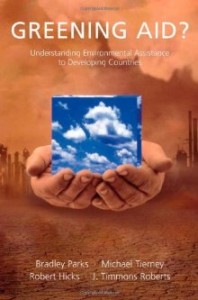In Greening Aid?, authored by Bradley Parks et al, reviewer Barbara Richter finds that the authors struggle to get the data balance right but overall present an informative and enjoyable read.
Greening Aid? Understanding the Environmental Impact of Development Assistance. Robert L. Hicks, Bradley C. Parks, J. Timmons Roberts and Michael J. Tierney. Oxford University Press. 2010.
 Has development aid become more focused on the environment over time? This is the central question that the authors, all of The College of William and Mary, discuss, in this new paperback edition. As part of their discussion, they look at who pays development aid to whom, how much is paid in total, and how much of that total can be reasonably classified as environmental aid. They also go one step further and try to analyse how donor countries decide on how much aid to give for environmental and other projects and how much of it to channel through international agencies.
Has development aid become more focused on the environment over time? This is the central question that the authors, all of The College of William and Mary, discuss, in this new paperback edition. As part of their discussion, they look at who pays development aid to whom, how much is paid in total, and how much of that total can be reasonably classified as environmental aid. They also go one step further and try to analyse how donor countries decide on how much aid to give for environmental and other projects and how much of it to channel through international agencies.
 The authors begin by introducing their dataset, a large collection of aid projects financed by states or multilateral aid agencies, with information on donors and recipients, the amounts paid and a basic classification into ‘environmentally friendly’, ‘environmentally neutral’ and ‘environmentally harmful’ projects. Environmentally friendly projects are further partitioned into ‘green’ (projects that help the environment on a global or at least regional scale) and ‘brown’ (projects that help only the local environment). The scope of this dataset, even with all the limitations the authors acknowledge, is stunning and it is publicly available for free.
The authors begin by introducing their dataset, a large collection of aid projects financed by states or multilateral aid agencies, with information on donors and recipients, the amounts paid and a basic classification into ‘environmentally friendly’, ‘environmentally neutral’ and ‘environmentally harmful’ projects. Environmentally friendly projects are further partitioned into ‘green’ (projects that help the environment on a global or at least regional scale) and ‘brown’ (projects that help only the local environment). The scope of this dataset, even with all the limitations the authors acknowledge, is stunning and it is publicly available for free.
In the following chapters, descriptive analysis and case studies of donor and recipient countries and organisations alternate with more advanced statistical methods to evaluate how total aid and environmental aid have evolved from 1980 to 1999. They first look at overall patterns (both total aid and environmental aid have gone up, environmental aid more so), then ask more detailed questions: which states receive most aid and why (China, India, Brazil, Kenya, and somewhat improbably Egypt); which countries give most environmental aid bilaterally and why (UK, USA, Denmark, Germany, and Japan); which countries give most environmental aid through multilateral agencies, and how do these agencies allocate their funds. The UK’s Department For International Development is given its own case study thanks to being frontrunner for most improved aid agency after Labour came to power in 1997.
The authors try to analyse these questions in a unified theoretical framework that provides a series of compelling logical links from the decisions of voters in donor countries, to the decisions of donor governments on bilateral and multilateral aid, to negotiating power of governments in countries receiving aid. The book ends with a list of ten guiding principles for better implementation of environmental aid in the future, but unfortunately this list is the book’s most grating flaw. The points on the list all seem to be sensible enough, but if they follow from the analysis in the first eight chapters of the book I completely missed the connection. Overall, the descriptive analysis is extremely interesting, full of information and has some surprising titbits and case studies. Did you know that Kenya has had environmental legislation since 1965?
The authors are first to acknowledge that their statistical analysis is far from perfect, suffering from a shortage of high quality data, both for information on projects and on factors that might be expected to influence the flows of aid at different stages. In describing their estimation procedures, however, their attempt to satisfy two very different audiences backfires: readers without any statistical background will find the information given barely comprehensible, while readers with some statistical background will find this same information insufficient. The authors point to a companion paper that explains technical details, but I had trouble finding that paper. Given that the descriptive parts were so well written and fascinating, simply writing about the estimation results in a qualitative and non-technical way and collecting all statistical material, including the estimation result tables, in an extended appendix or the elusive companion paper might have been a better idea.
Despite these negatives, I thoroughly recommend the book. I enjoyed reading it, and I learned a lot about the greening of aid since 1980.
This review was originally published on the LSE British Politics and Policy blog on 3rd April 2011.
——————————————————————————————-
Barbara Richter is a PhD student in the Department of Economics at the LSE. Her areas of specialisation are growth and technology and natural resource conflicts. Before she came to LSE, Barbara obtained undergraduate degrees in economics and political science at a German university.







